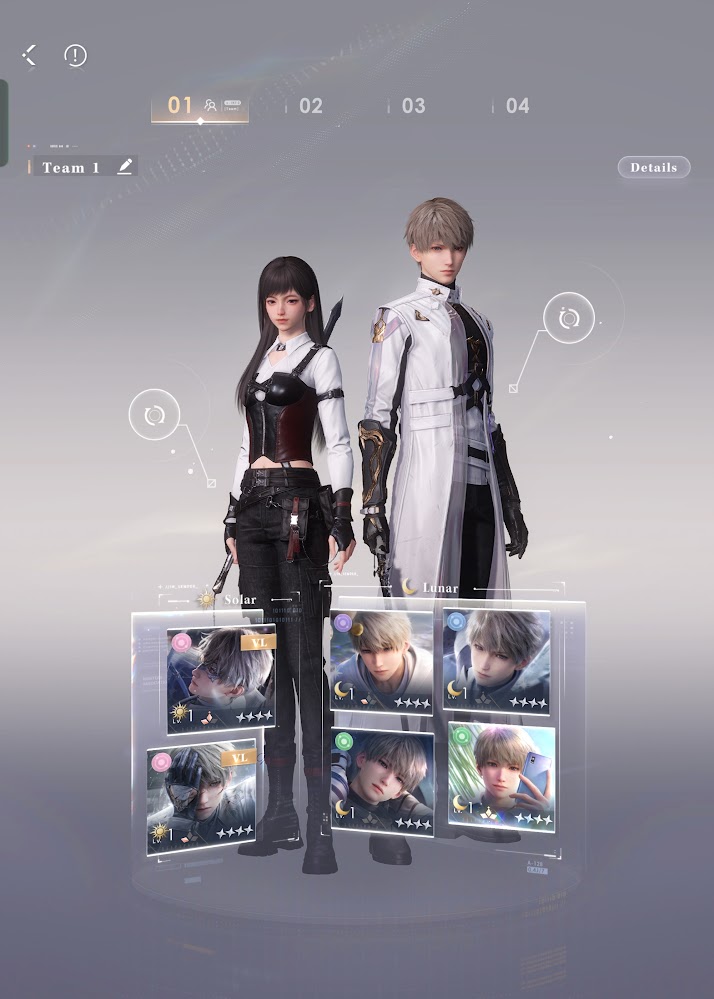Recommended order
- Starting point
- Memories cards ⇐ you are here
- Team building
- Combat basics
- Protocores basics
Introduction
Cards in Love and Deepspace are called “Memories”. They can have varying stella, rarity and rank, and are classified as solar or lunar.
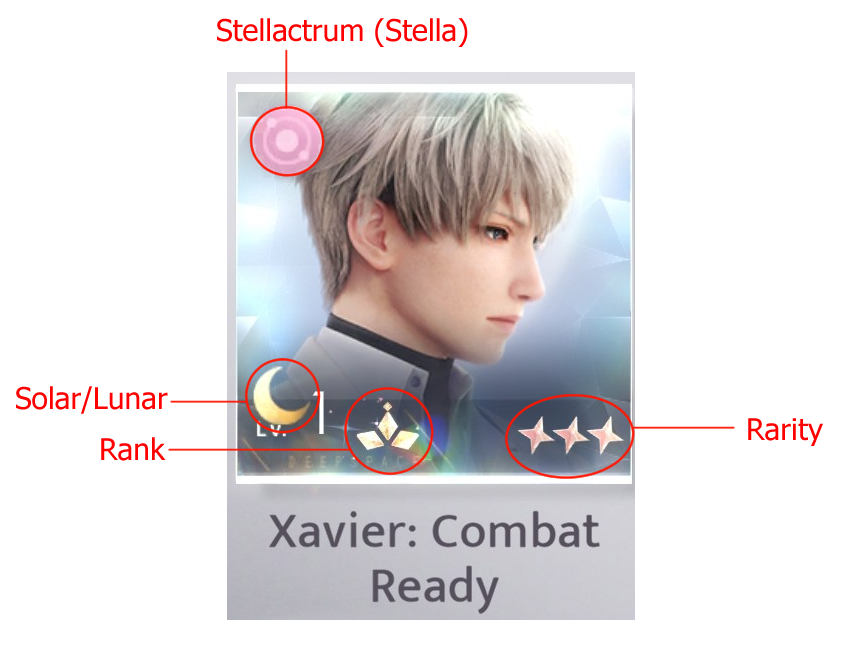
Stellactrum
All cards can be sorted by their stellactrum, or stella for short. There are only six stella that each card can be sorted into:
- Emerald (green)
- Sapphire (blue)
- Violet (purple)
- Amber (yellow)
- Ruby (red)
- Pearl (pink)
Each LI will have a stella prioritization (below table), meaning they are more likely to have cards of a certain stella.
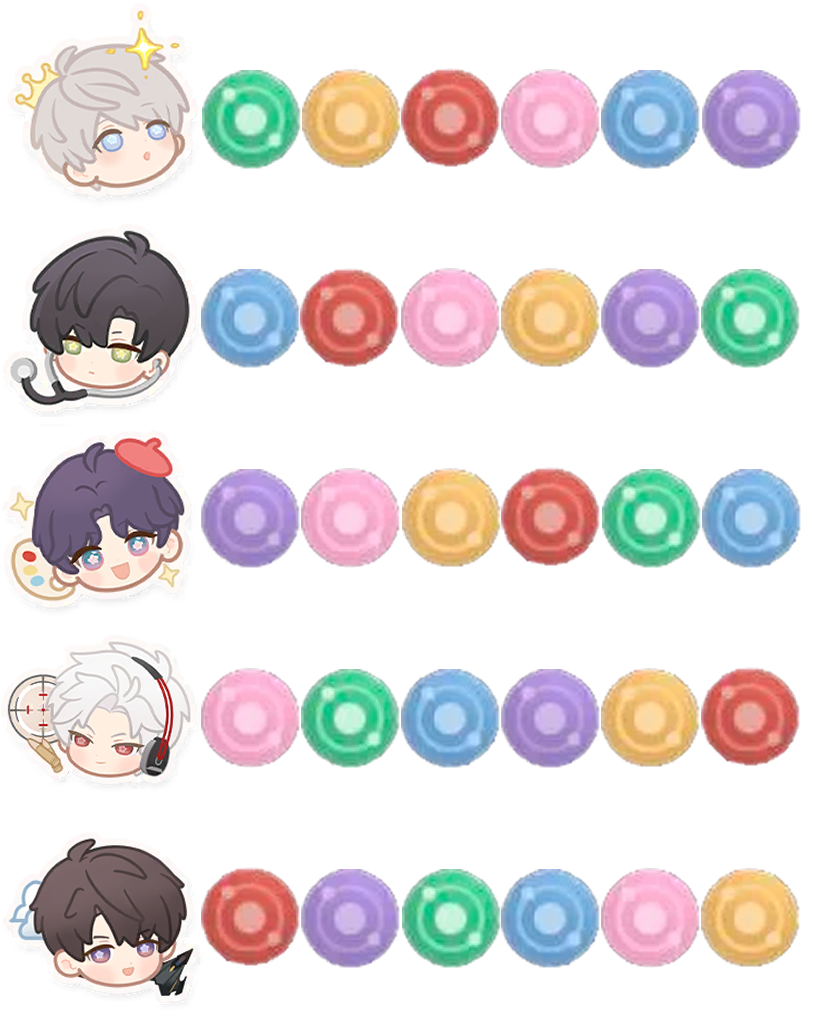
Primary and secondary stella are essential for fighting in orbits and should be leveled first. Tertiary colours become important when fighting in high level orbits with the release of 3rd myths. 4th, 5th, and 6th stella are considered “off colour” and are considered low priority when managing resources to level cards.
Stella are important when entering battles with protofield stellactrum. Please see our stella match vs brute force page for an in depth guide on how to use a card’s stella in team building.
Card Rarity & Ranks
Memories in this game can be of three rarities: 3⭐ (R), 4⭐ (SR) or 5⭐ (SSR). As rarity increases, so do the card’s base stats.
Cards gain ranks when you obtain multiple copies of the card. These copies are converted to shards, which are used to rank up a card. Shards can also be obtained in the galaxy explorer (GE). We refer to card ranks with the short form of R0, R1, R2, and R3.
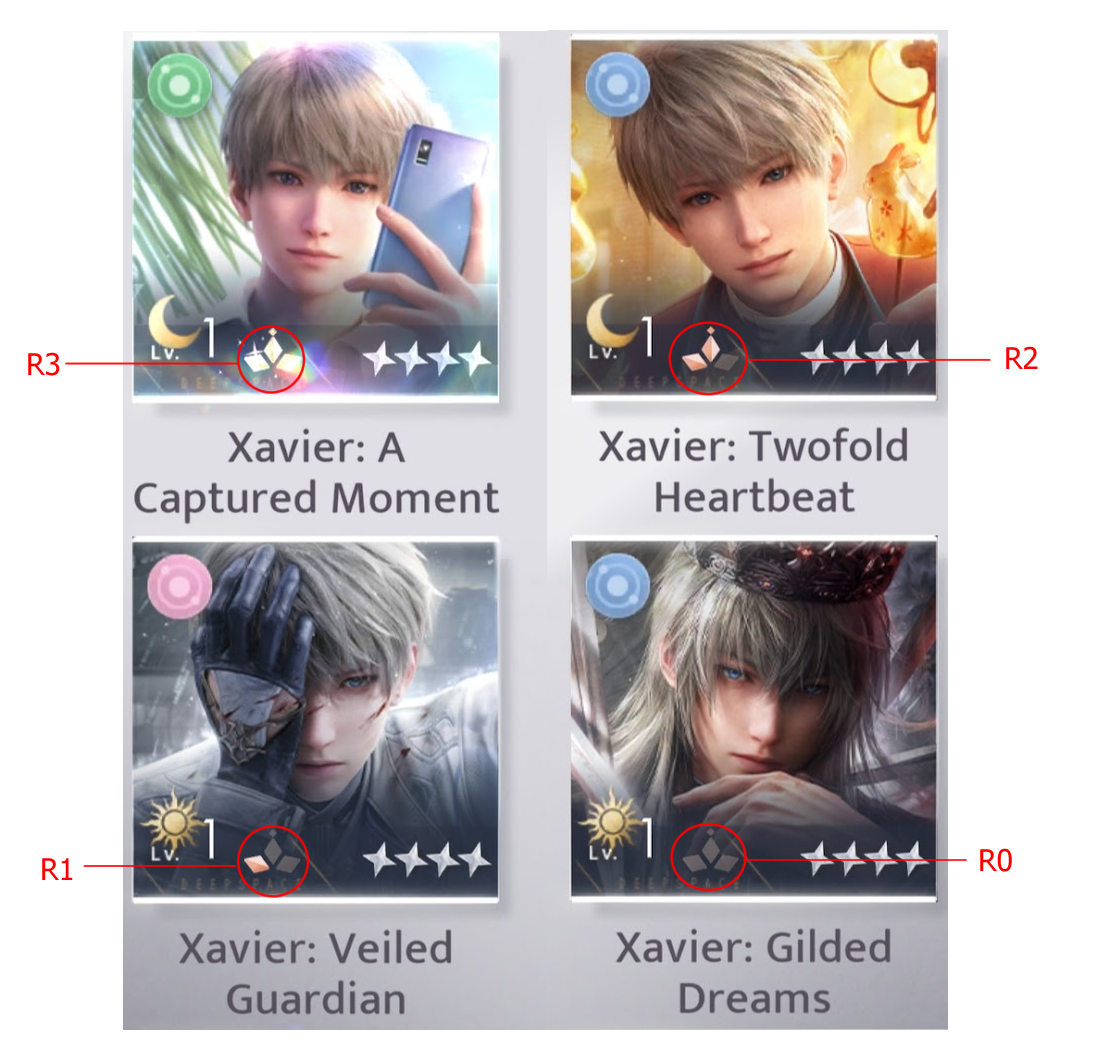
Ranking a card will increase the card’s base stats but never above a similarly leveled higher rarity card (ie. An R3 4⭐ card at level 1 will have lower stats than an R0 5⭐ card also at level 1.) An R0 5⭐ card will have nearly twice the base stats of an R3 3⭐ card - this is why it is generally not recommended to level 3⭐ cards at all.
Ranking a solar card will grant additional Crit DMG, while ranking a lunar card will grant additional Crit rate.
Solar vs Lunar Cards
Cards are sorted into solar or lunar functionality and are identified by symbols.
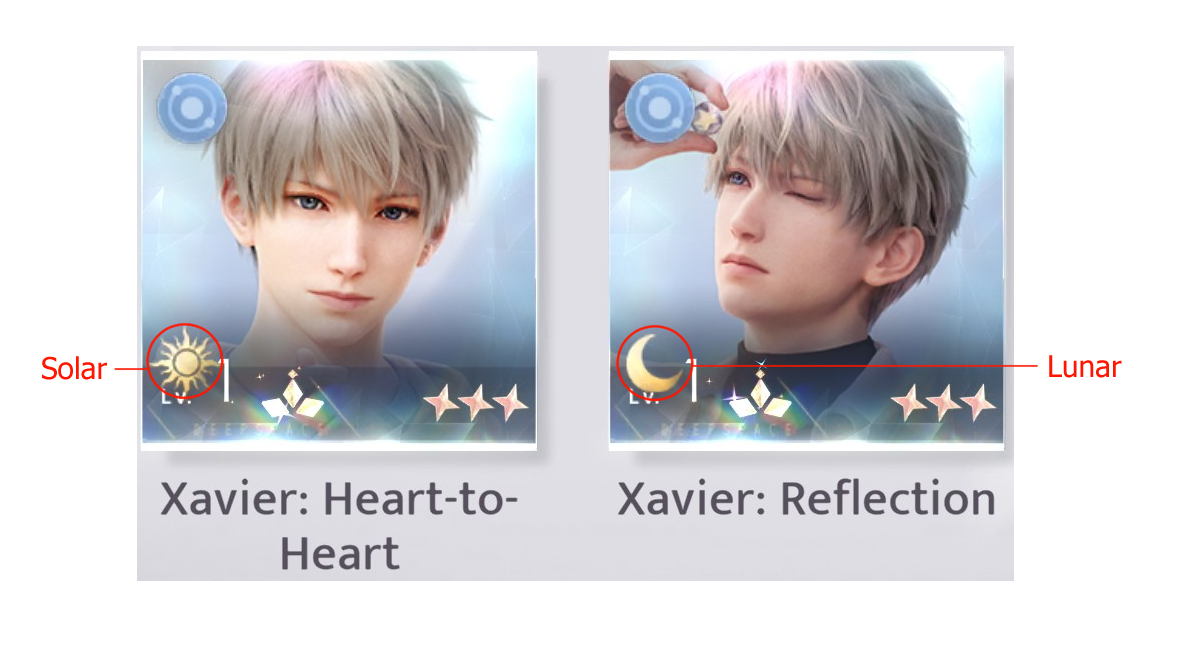
Once you’ve reached Hunter Level 40, you will have access to a full team of 6 cards/memories. Each memory’s stats are added to the total team’s stats and not all of the 6 slots have to be filled to be deployed.
- Lunar cards do not provide any bonus to the team, only stats.
- Solar cards grant a special boost to the team from “pair bonuses” and can change a companion’s gameplay.
Solar Pairs
Apart from 3⭐, solar cards come as a pair and are identified by a ribbon with two letters on their memory icon. When two solar cards have matching letters, they activate a “pair bonus”.
Ranked solar pair
A solar pair is only considered ranked when both cards have been ranked to the same level. If they are not the same, the rank of the pair will be the same as the card with the lowest rank.
For example, in the image below, the pair in use is an “R1 VL”.

Pair bonuses for 4⭐ solar pairs are all the same:
- R0: Increases DMG by 5%
- R1: Increases oath recovery boost by 10%
- R2: Reduces DMG taken by 5%
- R3: Increase DMG by 5%
Pair bonuses for 5⭐ solar pairs (myths) have both passive bonuses as well as active bonuses that are unique to the companion kit (listed in their individual companion guides).
Passive bonuses are the same for all myth pairs:
- R0: Increases DMG by 8% and reduces DMG taken by 8%
- R1: Boost oath recovery boost by 20%
- R2: Adds a permanent extra energy charge (also unlocks the special colour for the companion)
- R3: Increases DMG by 8% and reduces DMG taken by 8%
Pair bonus
Pair bonuses are additive (ex. if you have an R2 pair, you receive all the bonuses listed for R0, R1, and R2).
R-1
When discussing Myth companions, “R-1” is often used to describe a team using a Myth companion that does not match the solar pair cards.
Myth companion on 4⭐ solar pair
For example, in the below team set up, the solar pair is the 4⭐ R1 VL, but the companion is Lightseeker. Lightseeker has his own 5⭐ solar cards (LT), which are not deployed on this team. In this team, only the VL pair bonuses apply, and none of the LT pair bonuses apply (if your account has an R3 LT pair, none of those pair bonuses apply to this R1 VL team).
In this case, we often call it an R-1 LT: you can use LT’s base companion kit, but do not have access to any of the myth pair bonuses. This can often completely change the companion’s gameplay.
Myth companion with different 5⭐ solar pair
In the case of using 5⭐ companions with 5⭐ solar cards that do not belong to the companion, then the passive 5⭐ bonuses would apply, but not the companion-specific active bonuses.
For example, in the Sylus team below, the 5⭐ Abysm Sovereign (AS) companion is being used on a R2 Relentless Conqueror (CA) solar pair. In this case, the R-1 AS companion would have the 8% DMG bonus, 8% reduced DMG taken, 20% oath recovery, and the 4th energy charge granted by the R2 CA passive pair bonuses, but none of the kit specific bonuses (listed in the companion guide). Typically, the higher the rank of the 5⭐ solar pair cards, the less ideal it is to use a different companion, as you lose out on a lot of additional damage from the companion-specific pair bonuses
How to Read a Card’s Stats
Each card is individually built and a summary of the card’s stats can be seen at the bottom of a memory.
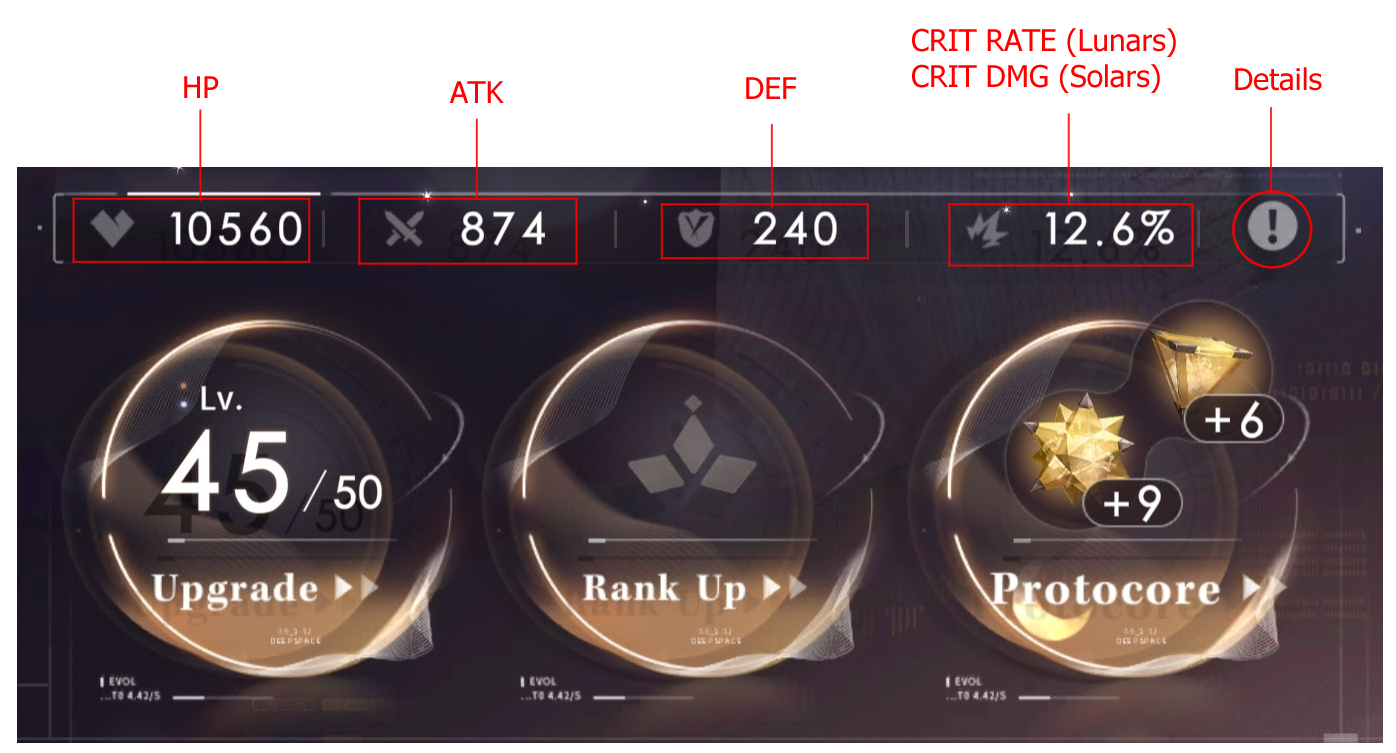
Clicking on the details button opens up a box that breaks down all the stats on that card that are not summarized on the main screen. There are three sections: basic stats, advanced stats, and card talent:
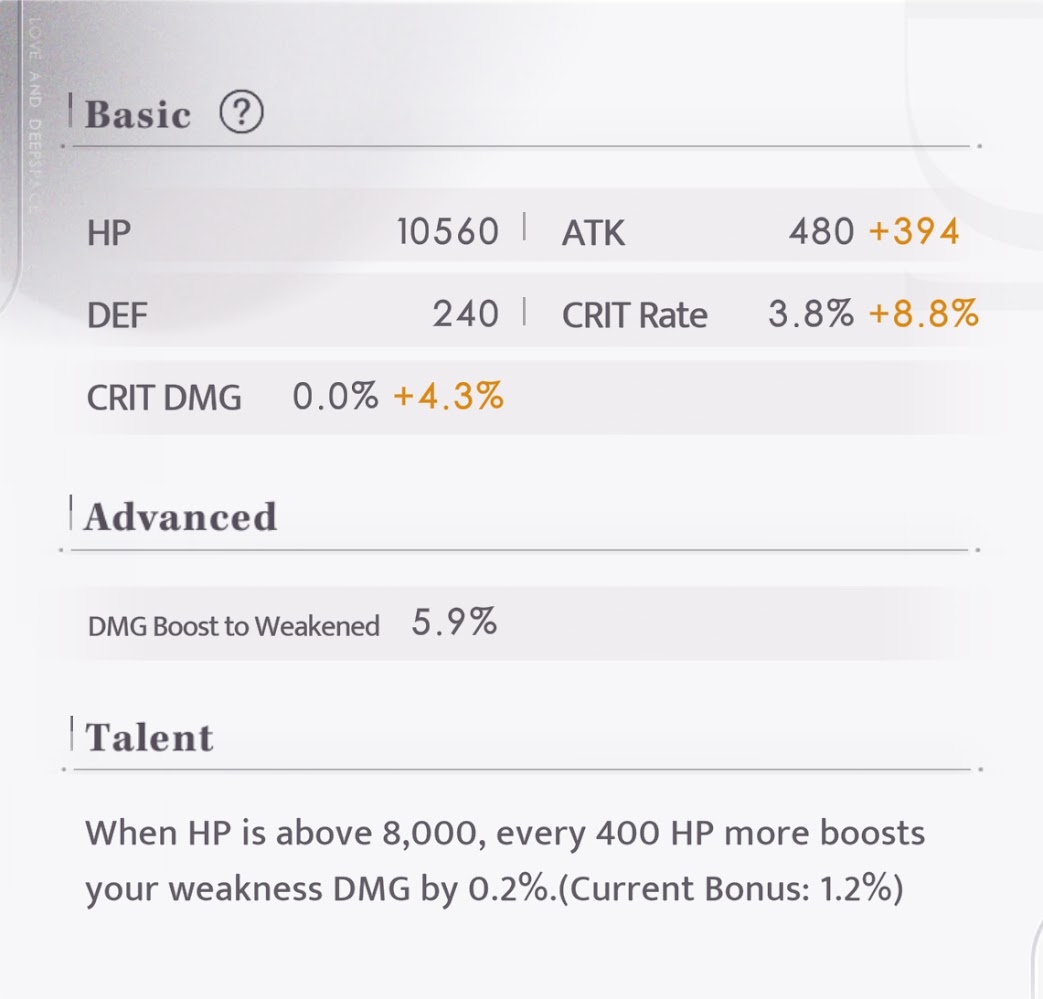
Basic Stats
The card’s base stats are listed in Black, while any additional stats from cores are listed in Yellow. In the above example, the equipped cores have no added HP and DEF, but add 394 ATK, 8.8% crit rate and 4.3% crit dmg. The sum of the black and yellow values are shown on the main memory screen (for example, 480 + 394 ATK add up to the 874 ATK in the previous image)
Advanced Stats
Listed here are Oath’s Strength, Expedited Energy Boost, Oath Recovery Boost and DMG Boost to Weakened. The DMG Boost to Weakened value includes any core substats as well as talent bonus. In the above image, there is a total of 5.9% D2W: 1.2% comes from the card talent, and the remaining 4.7% is from the equipped cores.
Oath Recovery Boost
Any oath boost from an R1 solar pair passive bonus is not shown here as part of the Oath Recovery Boost stat.
Card Talents
All cards come with a talent that is used to increase the card’s D2W. Card talents should not be considered in most team set-ups, and are only used to passively add additional D2W stats to the team. Advanced players can try to match lunar talents with their companion if they are brute forcing or using minstats for a stage.
A card’s talent is used to determine the card’s base stats, and are not dependent on whether it is a solar card or a lunar card. All 5⭐ cards with an ATK talent at the same rank will have the same base stats, all 5⭐ cards with an HP talent at the same rank will have the same base stats, etc.
Cards stats table
5 star cards
ATK talented
Tables
Level ATK DEF HP Crit Rate (for lunars) Crit DMG (for solars) D2W Before Ascension After Ascension Before Ascension After Ascension Before Ascension After Ascension Before Ascension After Ascension Before Ascension After Ascension Before Ascension After Ascension 1 132 - 60 - 2400 - 2.6% - 5.2% - 0.0% - 10 191 212 87 99 3480 3960 2.6% 2.9% 5.2% 5.8% 0.0% 0.0% 20 283 310 129 141 5160 5640 2.9% 3.2% 5.8% 6.4% 0.0% 0.0% 30 376 402 171 183 6840 7320 3.2% 3.5% 6.4% 7.0% 0.0% 0.0% 40 468 495 213 225 8520 9000 3.5% 3.8% 7.0% 7.6% 0.6% 0.8% 50 561 587 255 267 10200 10680 3.8% 4.1% 7.6% 8.2% 1.6% 1.8% 60 653 679 297 309 11880 12360 4.1% 4.4% 8.2% 8.8% 2.4% 2.6% 70 745 772 339 351 13560 14040 4.4% 4.7% 8.8% 9.4% 3.4% 3.6% 80 838 904 381 411 15240 16440 4.7% 5.5% 9.4% 11.0% 4.2% 5.0%
Level ATK DEF HP Crit Rate (for lunars) Crit DMG (for solars) D2W Before Ascension After Ascension Before Ascension After Ascension Before Ascension After Ascension Before Ascension After Ascension Before Ascension After Ascension Before Ascension After Ascension 1 147 - 67 - 2688 - 4.1% - 8.2% - 0.0% - 10 214 243 97 110 3897 4435 4.1% 4.4% 8.2% 8.8% 0.0% 0.0% 20 317 347 144 157 5779 6316 4.4% 4.7% 8.8% 9.4% 0.0% 0.0% 30 421 450 191 204 7660 8198 4.7% 5.0% 9.4% 10.0% 0.2% 0.4% 40 524 554 238 252 9542 10080 5.0% 5.3% 10.0% 10.6% 1.2% 1.4% 50 628 657 285 299 11424 11961 5.3% 5.6% 10.6% 11.2% 2.2% 2.4% 60 731 761 332 346 13305 13843 5.6% 5.9% 11.2% 11.8% 3.2% 3.6% 70 835 864 379 393 15187 15724 5.9% 6.2% 11.8% 12.4% 4.2% 4.6% 80 938 1012 426 460 17068 18412 6.2% 7.0% 12.4% 14.0% 5.2% 6.0%
Level ATK DEF HP Crit Rate (for lunars) Crit DMG (for solars) D2W Before Ascension After Ascension Before Ascension After Ascension Before Ascension After Ascension Before Ascension After Ascension Before Ascension After Ascension Before Ascension After Ascension 1 163 - 74 - 2976 - 5.6% - 11.2% - 0.0% - 10 237 270 107 122 4315 4910 5.6% 5.9% 11.2% 11.8% 0.0% 0.0% 20 351 384 159 174 6398 6993 5.9% 6.2% 11.8% 12.4% 0.0% 0.0% 30 466 499 212 226 8481 9076 6.2% 6.5% 12.4% 13.0% 0.6% 0.8% 40 581 613 264 279 10564 11160 6.5% 6.8% 13.0% 13.6% 1.8% 2.0% 50 695 728 316 331 12648 13243 6.8% 7.1% 13.6% 14.2% 2.8% 3.2% 60 810 842 368 383 14731 15326 7.1% 7.4% 14.2% 14.8% 4.0% 4.4% 70 924 957 420 435 16814 17409 7.4% 7.7% 14.8% 15.4% 5.2% 5.4% 80 1039 1121 472 509 18897 20385 7.7% 8.5% 15.4% 17.0% 6.2% 7.2%
Level ATK DEF HP Crit Rate (for lunars) Crit DMG (for solars) D2W Before Ascension After Ascension Before Ascension After Ascension Before Ascension After Ascension Before Ascension After Ascension Before Ascension After Ascension Before Ascension After Ascension 1 179 - 81 - 3264 - 7.1% - 14.2% - 0.0% - 10 260 296 118 134 4732 5385 7.1% 7.4% 14.2% 14.8% 0.0% 0.0% 20 385 421 175 191 7017 7670 7.4% 7.7% 14.8% 15.4% 0.0% 0.2% 30 511 547 232 248 9302 9955 7.7% 8.0% 15.4% 16.0% 1.0% 1.4% 40 637 673 289 306 11587 12240 8.0% 8.3% 16.0% 16.6% 2.2% 2.6% 50 762 798 346 363 13872 14524 8.3% 8.6% 16.6% 17.2% 3.6% 3.8% 60 888 924 403 420 16156 16809 8.6% 8.9% 17.2% 17.8% 4.8% 5.2% 70 1014 1050 461 477 18441 19094 8.9% 9.2% 17.8% 18.4% 6.0% 6.4% 80 1139 1229 518 558 20726 22358 9.2% 10.0% 18.4% 20.0% 7.2% 8.2% HP talented
Tables
Level ATK DEF HP Crit Rate (for lunars) Crit DMG (for solars) D2W Before Ascension After Ascension Before Ascension After Ascension Before Ascension After Ascension Before Ascension After Ascension Before Ascension After Ascension Before Ascension After Ascension 1 120 - 60 - 2640 - 2.6% - 5.2% - 0.0% - 10 174 198 87 99 3828 4356 2.6% 2.9% 5.2% 5.8% 0.0% 0.0% 20 258 282 129 141 5676 6204 2.9% 3.2% 5.8% 6.4% 0.0% 0.0% 30 342 366 171 183 7524 8052 3.2% 3.5% 6.4% 7.0% 0.0% 0.0% 40 426 450 213 225 9372 9900 3.5% 3.8% 7.0% 7.6% 0.6% 0.8% 50 510 534 255 267 11220 11748 3.8% 4.1% 7.6% 8.2% 1.6% 1.8% 60 594 618 297 309 13068 13596 4.1% 4.4% 8.2% 8.8% 2.4% 2.6% 70 678 702 339 351 14916 15444 4.4% 4.7% 8.8% 9.4% 3.4% 3.6% 80 762 822 381 411 16764 18084 4.7% 5.5% 9.4% 11.0% 4.2% 5.0%
Level ATK DEF HP Crit Rate (for lunars) Crit DMG (for solars) D2W Before Ascension After Ascension Before Ascension After Ascension Before Ascension After Ascension Before Ascension After Ascension Before Ascension After Ascension Before Ascension After Ascension 1 134 - 67 - 2956 - 4.1% - 8.2% - 0.0% - 10 194 221 97 110 4287 4878 4.1% 4.4% 8.2% 8.8% 0.0% 0.0% 20 288 315 144 157 6357 6948 4.4% 4.7% 8.8% 9.4% 0.0% 0.0% 30 383 409 191 204 8426 9018 4.7% 5.0% 9.4% 10.0% 0.2% 0.4% 40 477 504 238 252 10496 11088 5.0% 5.3% 10.0% 10.6% 1.2% 1.4% 50 571 598 285 299 12566 13157 5.3% 5.6% 10.6% 11.2% 2.2% 2.4% 60 665 692 332 346 14636 15227 5.6% 5.9% 11.2% 11.8% 3.2% 3.6% 70 759 786 379 393 16705 17297 5.9% 6.2% 11.8% 12.4% 4.2% 4.6% 80 853 920 426 460 18775 20254 6.2% 7.0% 12.4% 14.0% 5.2% 6.0%
Level ATK DEF HP Crit Rate (for lunars) Crit DMG (for solars) D2W Before Ascension After Ascension Before Ascension After Ascension Before Ascension After Ascension Before Ascension After Ascension Before Ascension After Ascension Before Ascension After Ascension 1 134 - 67 - 2956 - 5.6% - 11.2% 0.0% - 10 194 221 97 110 4287 4878 5.6% 5.9% 11.2% 11.8% 0.0% 0.0% 20 288 315 144 157 6357 6948 5.9% 6.2% 11.8% 12.4% 0.0% 0.0% 30 383 409 191 204 8426 9018 6.2% 6.5% 12.4% 13.0% 0.6% 0.8% 40 477 504 238 252 10496 11088 6.5% 6.8% 13.0% 13.6% 1.8% 2.0% 50 571 598 285 299 12566 13157 6.8% 7.1% 13.6% 14.2% 2.8% 3.2% 60 665 692 332 346 14636 15227 7.1% 7.4% 14.2% 14.8% 4.0% 4.4% 70 759 786 379 393 16705 17297 7.4% 7.7% 14.8% 15.4% 5.2% 5.4% 80 853 920 426 460 18775 20254 7.7% 8.5% 15.4% 17.0% 6.2% 7.2%
Level ATK DEF HP Crit Rate (for lunars) Crit DMG (for solars) D2W Before Ascension After Ascension Before Ascension After Ascension Before Ascension After Ascension Before Ascension After Ascension Before Ascension After Ascension Before Ascension After Ascension 1 163 - 81 - 3590 - 7.1% - 14.2% 0.0% - 10 236 269 118 134 5206 5924 7.1% 7.4% 14.2% 14.8% 0.0% 0.0% 20 350 383 175 191 7719 8437 7.4% 7.7% 14.8% 15.4% 0.0% 0.2% 30 465 497 232 248 10232 10950 7.7% 8.0% 15.4% 16.0% 1.0% 1.4% 40 579 612 289 306 12745 13464 8.0% 8.3% 16.0% 16.6% 2.2% 2.6% 50 693 726 346 363 15259 15977 8.3% 8.6% 16.6% 17.2% 3.6% 3.8% 60 807 840 403 420 17772 18490 8.6% 8.9% 17.2% 17.8% 4.8% 5.2% 70 922 954 461 477 20285 21003 8.9% 9.2% 17.8% 18.4% 6.0% 6.4% 80 1036 1117 518 558 22799 24594 9.2% 10.0% 18.4% 20.0% 7.2% 8.2% Link to originalDEF talented
Tables
Level ATK DEF HP Crit Rate (for lunars) Crit DMG (for solars) D2W Before Ascension After Ascension Before Ascension After Ascension Before Ascension After Ascension Before Ascension After Ascension Before Ascension After Ascension Before Ascension After Ascension 1 120 - 66 - 2400 - 2.6% - 5.2% - 0.0% - 10 174 198 95 108 3480 3960 2.6% 2.9% 5.2% 5.8% 0.0% 0.0% 20 258 282 141 155 5160 5640 2.9% 3.2% 5.8% 6.4% 0.0% 0.0% 30 342 366 188 201 6840 7320 3.2% 3.5% 6.4% 7.0% 0.0% 0.0% 40 426 450 234 247 8520 9000 3.5% 3.8% 7.0% 7.6% 0.6% 0.8% 50 510 534 280 293 10200 10680 3.8% 4.1% 7.6% 8.2% 1.6% 1.8% 60 594 618 326 339 11880 12360 4.1% 4.4% 8.2% 8.8% 2.4% 2.6% 70 678 702 372 386 13560 14040 4.4% 4.7% 8.8% 9.4% 3.4% 3.6% 80 762 822 419 452 15240 16440 4.7% 5.5% 9.4% 11.0% 4.2% 5.0%
Level ATK DEF HP Crit Rate (for lunars) Crit DMG (for solars) D2W Before Ascension After Ascension Before Ascension After Ascension Before Ascension After Ascension Before Ascension After Ascension Before Ascension After Ascension Before Ascension After Ascension 1 134 - 73 - 2688 - 4.1% - 8.2% - 0.0% - 10 194 221 107 121 3897 4435 4.1% 4.4% 8.2% 8.8% 0.0% 0.0% 20 288 315 158 173 5779 6316 4.4% 4.7% 8.8% 9.4% 0.0% 0.0% 30 383 409 210 225 7660 8198 4.7% 5.0% 9.4% 10.0% 0.2% 0.4% 40 477 504 262 277 9542 10080 5.0% 5.3% 10.0% 10.6% 1.2% 1.4% 50 571 598 314 328 11424 11961 5.3% 5.6% 10.6% 11.2% 2.2% 2.4% 60 665 692 365 380 13305 13843 5.6% 5.9% 11.2% 11.8% 3.2% 3.6% 70 759 786 417 432 15187 15724 5.9% 6.2% 11.8% 12.4% 4.2% 4.6% 80 853 920 469 506 17068 18412 6.2% 7.0% 12.4% 14.0% 5.2% 6.0%
Level ATK DEF HP Crit Rate (for lunars) Crit DMG (for solars) D2W Before Ascension After Ascension Before Ascension After Ascension Before Ascension After Ascension Before Ascension After Ascension Before Ascension After Ascension Before Ascension After Ascension 1 148 - 81 - 2976 - 5.6% - 11.2% 0.0% - 10 215 245 118 135 4315 4910 5.6% 5.9% 11.2% 11.8% 0.0% 0.0% 20 319 349 175 192 6398 6993 5.9% 6.2% 11.8% 12.4% 0.0% 0.0% 30 424 453 233 249 8481 9076 6.2% 6.5% 12.4% 13.0% 0.6% 0.8% 40 528 558 290 306 10564 11160 6.5% 6.8% 13.0% 13.6% 1.8% 2.0% 50 632 662 347 364 12648 13243 6.8% 7.1% 13.6% 14.2% 2.8% 3.2% 60 736 766 405 421 14731 15326 7.1% 7.4% 14.2% 14.8% 4.0% 4.4% 70 840 870 462 478 16814 17409 7.4% 7.7% 14.8% 15.4% 5.2% 5.4% 80 944 1019 519 560 18897 20385 7.7% 8.5% 15.4% 17.0% 6.2% 7.2%
Level ATK DEF HP Crit Rate (for lunars) Crit DMG (for solars) D2W Before Ascension After Ascension Before Ascension After Ascension Before Ascension After Ascension Before Ascension After Ascension Before Ascension After Ascension Before Ascension After Ascension 1 163 - 89 - 3264 - 7.1% - 14.2% 0.0% - 10 236 269 130 148 4732 5385 7.1% 7.4% 14.2% 14.8% 0.0% 0.0% 20 350 383 192 210 7017 7670 7.4% 7.7% 14.8% 15.4% 0.0% 0.2% 30 465 497 255 273 9302 9955 7.7% 8.0% 15.4% 16.0% 1.0% 1.4% 40 579 612 318 336 11587 12240 8.0% 8.3% 16.0% 16.6% 2.2% 2.6% 50 693 726 381 399 13872 14524 8.3% 8.6% 16.6% 17.2% 3.6% 3.8% 60 807 840 444 462 16156 16809 8.6% 8.9% 17.2% 17.8% 4.8% 5.2% 70 922 954 507 525 18441 19094 8.9% 9.2% 17.8% 18.4% 6.0% 6.4% 80 1036 1117 569 614 20726 22358 9.2% 10.0% 18.4% 20.0% 7.2% 8.2%
4 star cards
ATK talented
Tables
Level ATK DEF HP Crit Rate (for lunars) Crit DMG (for solars) D2W Before Ascension After Ascension Before Ascension After Ascension Before Ascension After Ascension Before Ascension After Ascension Before Ascension After Ascension Before Ascension After Ascension 1 88 - 40 - 1608 - 1.7% - 3.4% - 0.0% - 10 128 145 58 66 2331 2653 1.7% 1.9% 3.4% 3.8% 0.0% 0.0% 20 190 207 86 94 3457 3778 1.9% 2.1% 3.8% 4.2% 0.0% 0.0% 30 252 269 114 122 4582 4904 2.1% 2.3% 4.2% 4.6% 0.0% 0.0% 40 313 331 142 150 5708 6030 2.3% 2.5% 4.6% 5.0% 0.0% 0.0% 50 375 393 170 178 6834 7155 2.5% 2.7% 5.0% 5.4% 0.0% 0.0% 60 437 455 198 207 7959 8281 2.7% 2.9% 5.4% 5.8% 0.2% 0.4% 70 499 517 227 235 9085 9406 2.9% 3.1% 5.8% 6.2% 0.8% 1.0% 80 561 605 255 275 10210 11014 3.1% 3.6% 6.2% 7.3% 1.6% 2.0%
Level ATK DEF HP Crit Rate (for lunars) Crit DMG (for solars) D2W Before Ascension After Ascension Before Ascension After Ascension Before Ascension After Ascension Before Ascension After Ascension Before Ascension After Ascension Before Ascension After Ascension 1 92 - 42 - 1688 - 2.2% - 4.4% - 0.0% - 10 134 153 61 69 2448 2785 2.2% 2.4% 4.4% 4.8% 0.0% 0.0% 20 199 218 90 99 3630 3967 2.4% 2.6% 4.8% 5.2% 0.0% 0.0% 30 264 283 120 128 4811 5149 2.6% 2.8% 5.2% 5.6% 0.0% 0.0% 40 329 348 149 158 5993 6331 2.8% 3.0% 5.6% 6.0% 0.0% 0.0% 50 394 413 179 187 7175 7513 3.0% 3.2% 6.0% 6.4% 0.0% 0.0% 60 459 478 208 217 8357 8695 3.2% 3.4% 6.4% 6.8% 0.4% 0.6% 70 524 543 238 246 9539 9877 3.4% 3.6% 6.8% 7.2% 1.2% 1.4% 80 589 636 268 289 10721 11565 3.6% 4.1% 7.2% 8.3% 1.8% 2.2%
Level ATK DEF HP Crit Rate (for lunars) Crit DMG (for solars) D2W Before Ascension After Ascension Before Ascension After Ascension Before Ascension After Ascension Before Ascension After Ascension Before Ascension After Ascension Before Ascension After Ascension 1 97 - 44 - 1768 - 2.7% - 5.4% - 0.0% - 10 141 160 64 72 2564 2918 2.7% 2.9% 5.4% 5.8% 0.0% 0.0% 20 209 228 95 103 3802 4156 2.9% 3.1% 5.8% 6.2% 0.0% 0.0% 30 277 296 126 134 5041 5394 3.1% 3.3% 6.2% 6.6% 0.0% 0.0% 40 345 364 156 165 6279 6633 3.3% 3.5% 6.6% 7.0% 0.0% 0.0% 50 413 432 187 196 7517 7871 3.5% 3.7% 7.0% 7.4% 0.0% 0.2% 60 481 501 218 227 8755 9109 3.7% 3.9% 7.4% 7.8% 0.8% 1.0% 70 549 569 249 258 9993 10347 3.9% 4.1% 7.8% 8.2% 1.4% 1.6% 80 617 666 280 302 11231 12116 4.1% 4.6% 8.2% 9.3% 2.0% 2.6%
Level ATK DEF HP Crit Rate (for lunars) Crit DMG (for solars) D2W Before Ascension After Ascension Before Ascension After Ascension Before Ascension After Ascension Before Ascension After Ascension Before Ascension After Ascension Before Ascension After Ascension 1 101 - 46 - 1849 - 3.2% - 6.4% - 0.0% - 10 147 167 67 76 2681 3051 3.2% 3.4% 6.4% 6.8% 0.0% 0.0% 20 218 239 99 108 3975 4345 3.4% 3.6% 6.8% 7.2% 0.0% 0.0% 30 289 310 131 141 5270 5640 3.6% 3.8% 7.2% 7.6% 0.0% 0.0% 40 361 381 164 173 6564 6934 3.8% 4.0% 7.6% 8.0% 0.0% 0.0% 50 432 452 196 205 7859 8228 4.0% 4.2% 8.0% 8.4% 0.2% 0.4% 60 503 523 228 238 9153 9523 4.2% 4.4% 8.4% 8.8% 1.0% 1.2% 70 574 594 261 270 10447 10817 4.4% 4.6% 8.8% 9.2% 1.6% 1.8% 80 645 696 293 316 11742 12667 4.6% 5.1% 9.2% 10.3% 2.4% 2.8% HP talented
Tables
Level ATK DEF HP Crit Rate (for lunars) Crit DMG (for solars) D2W Before Ascension After Ascension Before Ascension After Ascension Before Ascension After Ascension Before Ascension After Ascension Before Ascension After Ascension Before Ascension After Ascension 1 80 - 40 - 1768 - 1.7% - 3.4% - 0.0% - 10 116 132 58 66 2564 2918 1.7% 1.9% 3.4% 3.8% 0.0% 0.0% 20 172 188 86 94 3802 4156 1.9% 2.1% 3.8% 4.2% 0.0% 0.0% 30 229 245 114 122 5041 5394 2.1% 2.3% 4.2% 4.6% 0.0% 0.0% 40 285 301 142 150 6279 6633 2.3% 2.5% 4.6% 5.0% 0.0% 0.0% 50 341 357 170 178 7517 7871 2.5% 2.7% 5.0% 5.4% 0.0% 0.0% 60 397 414 198 207 8755 9109 2.7% 2.9% 5.4% 5.8% 0.2% 0.4% 70 454 470 227 235 9993 10347 2.9% 3.1% 5.8% 6.2% 0.8% 1.0% 80 510 550 255 275 11231 12116 3.1% 3.6% 6.2% 7.3% 1.6% 2.0%
Level ATK DEF HP Crit Rate (for lunars) Crit DMG (for solars) D2W Before Ascension After Ascension Before Ascension After Ascension Before Ascension After Ascension Before Ascension After Ascension Before Ascension After Ascension Before Ascension After Ascension 1 84 - 42 - 1857 - 2.2% - 4.4% - 0.0% - 10 122 139 61 69 2692 3064 2.2% 2.4% 4.4% 4.8% 0.0% 0.0% 20 181 198 90 99 3993 4364 2.4% 2.6% 4.8% 5.2% 0.0% 0.0% 30 240 257 120 128 5293 5664 2.6% 2.8% 5.2% 5.6% 0.0% 0.0% 40 299 316 149 158 6593 6964 2.8% 3.0% 5.6% 6.0% 0.0% 0.0% 50 358 375 179 187 7893 8264 3.0% 3.2% 6.0% 6.4% 0.0% 0.0% 60 417 434 208 217 9193 9564 3.2% 3.4% 6.4% 6.8% 0.4% 0.6% 70 476 493 238 246 10493 10864 3.4% 3.6% 6.8% 7.2% 1.2% 1.4% 80 536 578 268 289 11793 12722 3.6% 4.1% 7.2% 8.3% 1.8% 2.2%
Level ATK DEF HP Crit Rate (for lunars) Crit DMG (for solars) D2W Before Ascension After Ascension Before Ascension After Ascension Before Ascension After Ascension Before Ascension After Ascension Before Ascension After Ascension Before Ascension After Ascension 1 88 - 44 - 1945 - 2.7% - 5.4% - 0.0% - 10 128 145 64 72 2821 3210 2.7% 2.9% 5.4% 5.8% 0.0% 0.0% 20 190 207 95 103 4183 4572 2.9% 3.1% 5.8% 6.2% 0.0% 0.0% 30 252 269 126 134 5545 5934 3.1% 3.3% 6.2% 6.6% 0.0% 0.0% 40 313 331 156 165 6907 7296 3.3% 3.5% 6.6% 7.0% 0.0% 0.0% 50 375 393 187 196 8269 8658 3.5% 3.7% 7.0% 7.4% 0.0% 0.2% 60 437 455 218 227 9631 10020 3.7% 3.9% 7.4% 7.8% 0.8% 1.0% 70 499 517 249 258 10993 11382 3.9% 4.1% 7.8% 8.2% 1.4% 1.6% 80 561 605 280 302 12355 13327 4.1% 4.6% 8.2% 9.3% 2.0% 2.6%
Level ATK DEF HP Crit Rate (for lunars) Crit DMG (for solars) D2W Before Ascension After Ascension Before Ascension After Ascension Before Ascension After Ascension Before Ascension After Ascension Before Ascension After Ascension Before Ascension After Ascension 1 92 - 46 - 2034 - 3.2% - 6.4% - 0.0% - 10 134 152 67 76 2949 3356 3.2% 3.4% 6.4% 6.8% 0.0% 0.0% 20 198 217 99 108 4373 4780 3.4% 3.6% 6.8% 7.2% 0.0% 0.0% 30 263 282 131 141 5797 6204 3.6% 3.8% 7.2% 7.6% 0.0% 0.0% 40 328 346 164 173 7221 7627 3.8% 4.0% 7.6% 8.0% 0.0% 0.0% 50 392 411 196 205 8645 9051 4.0% 4.2% 8.0% 8.4% 0.2% 0.4% 60 457 476 228 238 10068 10475 4.2% 4.4% 8.4% 8.8% 1.0% 1.2% 70 522 540 261 270 11492 11899 4.4% 4.6% 8.8% 9.2% 1.6% 1.8% 80 587 633 293 316 12916 13933 4.6% 5.1% 9.2% 10.3% 2.4% 2.8% Link to originalDEF talented
Tables
Level ATK DEF HP Crit Rate (for lunars) Crit DMG (for solars) D2W Before Ascension After Ascension Before Ascension After Ascension Before Ascension After Ascension Before Ascension After Ascension Before Ascension After Ascension Before Ascension After Ascension 1 80 - 44 - 1608 - 1.7% - 3.4% - 0.0% - 10 116 132 64 72 2331 2653 1.7% 1.9% 3.4% 3.8% 0.0% 0.0% 20 172 188 95 103 3457 3778 1.9% 2.1% 3.8% 4.2% 0.0% 0.0% 30 229 245 126 134 4582 4904 2.1% 2.3% 4.2% 4.6% 0.0% 0.0% 40 285 301 156 165 5708 6030 2.3% 2.5% 4.6% 5.0% 0.0% 0.0% 50 341 357 187 196 6834 7155 2.5% 2.7% 5.0% 5.4% 0.0% 0.0% 60 397 414 218 227 7959 8281 2.7% 2.9% 5.4% 5.8% 0.2% 0.4% 70 454 470 249 258 9085 9406 2.9% 3.1% 5.8% 6.2% 0.8% 1.0% 80 510 550 280 302 10210 11014 3.1% 3.6% 6.2% 7.3% 1.6% 2.0%
Level ATK DEF HP Crit Rate (for lunars) Crit DMG (for solars) D2W Before Ascension After Ascension Before Ascension After Ascension Before Ascension After Ascension Before Ascension After Ascension Before Ascension After Ascension Before Ascension After Ascension 1 84 - 46 - 1688 - 2.2% - 4.4% - 0.0% - 10 122 139 67 76 2448 2785 2.2% 2.4% 4.4% 4.8% 0.0% 0.0% 20 181 198 99 109 3630 3967 2.4% 2.6% 4.8% 5.2% 0.0% 0.0% 30 240 257 132 141 4811 5149 2.6% 2.8% 5.2% 5.6% 0.0% 0.0% 40 299 316 164 174 5993 6331 2.8% 3.0% 5.6% 6.0% 0.0% 0.0% 50 358 375 197 206 7175 7513 3.0% 3.2% 6.0% 6.4% 0.0% 0.0% 60 417 434 229 239 8357 8695 3.2% 3.4% 6.4% 6.8% 0.4% 0.6% 70 476 493 262 271 9539 9877 3.4% 3.6% 6.8% 7.2% 1.2% 1.4% 80 536 578 294 318 10721 11565 3.6% 4.1% 7.2% 8.3% 1.8% 2.2%
Level ATK DEF HP Crit Rate (for lunars) Crit DMG (for solars) D2W Before Ascension After Ascension Before Ascension After Ascension Before Ascension After Ascension Before Ascension After Ascension Before Ascension After Ascension Before Ascension After Ascension 1 88 - 48 - 1768 - 2.7% - 5.4% - 0.0% - 10 128 145 70 80 2564 2918 2.7% 2.9% 5.4% 5.8% 0.0% 0.0% 20 190 207 104 114 3802 4156 2.9% 3.1% 5.8% 6.2% 0.0% 0.0% 30 252 269 138 148 5041 5394 3.1% 3.3% 6.2% 6.6% 0.0% 0.0% 40 313 331 172 182 6279 6633 3.3% 3.5% 6.6% 7.0% 0.0% 0.0% 50 375 393 206 216 7517 7871 3.5% 3.7% 7.0% 7.4% 0.0% 0.2% 60 437 455 240 250 8755 9109 3.7% 3.9% 7.4% 7.8% 0.8% 1.0% 70 499 517 274 284 9993 10347 3.9% 4.1% 7.8% 8.2% 1.4% 1.6% 80 561 605 308 333 11231 12116 4.1% 4.6% 8.2% 9.3% 2.0% 2.6%
Level ATK DEF HP Crit Rate (for lunars) Crit DMG (for solars) D2W Before Ascension After Ascension Before Ascension After Ascension Before Ascension After Ascension Before Ascension After Ascension Before Ascension After Ascension Before Ascension After Ascension 1 92 - 50 - 1849 - 3.2% - 6.4% - 0.0% - 10 134 152 73 83 2681 3051 3.2% 3.4% 6.4% 6.8% 0.0% 0.0% 20 198 217 109 119 3975 4345 3.4% 3.6% 6.8% 7.2% 0.0% 0.0% 30 263 282 144 155 5270 5640 3.6% 3.8% 7.2% 7.6% 0.0% 0.0% 40 328 346 180 190 6564 6934 3.8% 4.0% 7.6% 8.0% 0.0% 0.0% 50 392 411 216 226 7859 8228 4.0% 4.2% 8.0% 8.4% 0.2% 0.4% 60 457 476 251 261 9153 9523 4.2% 4.4% 8.4% 8.8% 1.0% 1.2% 70 522 540 287 297 10447 10817 4.4% 4.6% 8.8% 9.2% 1.6% 1.8% 80 587 633 322 348 11742 12667 4.6% 5.1% 9.2% 10.3% 2.4% 2.8%
3 star cards
ATK talented
Tables
Level ATK DEF HP Crit Rate (for lunars) Crit DMG (for solars) D2W Before Ascension After Ascension Before Ascension After Ascension Before Ascension After Ascension Before Ascension After Ascension Before Ascension After Ascension Before Ascension After Ascension 1 55 - 25 - 1008 - 1.0% - 2.1% - 0.0% - 10 80 91 36 41 1461 1663 1.0% 1.2% 2.1% 2.4% 0.0% 0.0% 20 119 130 54 59 2167 2368 1.2% 1.3% 2.4% 2.6% 0.0% 0.0% 30 158 169 71 76 2872 3074 1.3% 1.4% 2.6% 2.9% 0.0% 0.0% 40 196 207 89 94 3578 3780 1.4% 1.5% 2.9% 3.1% 0.0% 0.0% 50 235 246 107 112 4284 4485 1.5% 1.7% 3.1% 3.4% 0.0% 0.0% 60 274 285 124 129 4989 5191 1.7% 1.8% 3.4% 3.6% 0.0% 0.0% 70 313 324 142 147 5695 5896 1.8% 1.9% 3.6% 3.9% 0.0% 0.0% 80 352 379 160 172 6400 6904 1.9% 2.3% 3.9% 4.6% 0.0% 0.0%
Level ATK DEF HP Crit Rate (for lunars) Crit DMG (for solars) D2W Before Ascension After Ascension Before Ascension After Ascension Before Ascension After Ascension Before Ascension After Ascension Before Ascension After Ascension Before Ascension After Ascension 1 58 - 26 - 1058 - 1.3% - 2.7% - 0.0% - 10 84 96 38 43 1534 1746 1.3% 1.5% 2.7% 3.0% 0.0% 0.0% 20 125 136 56 62 2275 2487 1.5% 1.6% 3.0% 3.2% 0.0% 0.0% 30 165 177 75 80 3016 3228 1.6% 1.7% 3.2% 3.5% 0.0% 0.0% 40 206 218 93 99 3757 3969 1.7% 1.8% 3.5% 3.7% 0.0% 0.0% 50 247 259 112 117 4498 4709 1.8% 2.0% 3.7% 4.0% 0.0% 0.0% 60 288 299 130 136 5239 5450 2.0% 2.1% 4.0% 4.2% 0.0% 0.0% 70 328 340 149 154 5979 6191 2.1% 2.2% 4.2% 4.5% 0.0% 0.0% 80 369 398 168 181 6720 7250 2.2% 2.6% 4.5% 5.2% 0.0% 0.0%
Level ATK DEF HP Crit Rate (for lunars) Crit DMG (for solars) D2W Before Ascension After Ascension Before Ascension After Ascension Before Ascension After Ascension Before Ascension After Ascension Before Ascension After Ascension Before Ascension After Ascension 1 60 - 27 - 1108 - 1.6% - 3.3% - 0.0% - 10 88 100 40 45 1607 1829 1.6% 1.8% 3.3% 3.6% 0.0% 0.0% 20 131 143 59 65 2383 2605 1.8% 1.9% 3.6% 3.8% 0.0% 0.0% 30 173 186 79 84 3160 3381 1.9% 2.0% 3.8% 4.1% 0.0% 0.0% 40 216 228 98 103 3936 4158 2.0% 2.1% 4.1% 4.3% 0.0% 0.0% 50 259 271 117 123 4712 4934 2.1% 2.3% 4.3% 4.6% 0.0% 0.0% 60 301 314 137 142 5488 5710 2.3% 2.4% 4.6% 4.8% 0.0% 0.0% 70 344 356 156 162 6264 6486 2.4% 2.5% 4.8% 5.1% 0.0% 0.0% 80 387 417 176 189 7040 7595 2.5% 2.9% 5.1% 5.8% 0.0% 0.0%
Level ATK DEF HP Crit Rate (for lunars) Crit DMG (for solars) D2W Before Ascension After Ascension Before Ascension After Ascension Before Ascension After Ascension Before Ascension After Ascension Before Ascension After Ascension Before Ascension After Ascension 1 63 - 28 - 1159 - 1.9% - 3.9% - 0.0% - 10 92 105 42 47 1680 1912 1.9% 2.1% 3.9% 4.2% 0.0% 0.0% 20 137 149 62 68 2492 2724 2.1% 2.2% 4.2% 4.4% 0.0% 0.0% 30 181 194 82 88 3303 3535 2.2% 2.3% 4.4% 4.7% 0.0% 0.0% 40 226 239 102 108 4115 4347 2.3% 2.4% 4.7% 4.9% 0.0% 0.0% 50 270 283 123 128 4926 5158 2.4% 2.6% 4.9% 5.2% 0.0% 0.0% 60 315 328 143 149 5738 5969 2.6% 2.7% 5.2% 5.4% 0.0% 0.0% 70 360 372 163 169 6549 6781 2.7% 2.8% 5.4% 5.7% 0.0% 0.0% 80 404 436 184 198 7360 7940 2.8% 3.2% 5.7% 6.4% 0.0% 0.2% HP talented
Tables
Level ATK DEF HP Crit Rate (for lunars) Crit DMG (for solars) D2W Before Ascension After Ascension Before Ascension After Ascension Before Ascension After Ascension Before Ascension After Ascension Before Ascension After Ascension Before Ascension After Ascension 1 50 - 25 - 1108 - 1.0% - 2.1% - 0.0% - 10 73 83 36 41 1607 1829 1.0% 1.2% 2.1% 2.4% 0.0% 0.0% 20 108 118 54 59 2383 2605 1.2% 1.3% 2.4% 2.6% 0.0% 0.0% 30 143 153 71 76 3160 3381 1.3% 1.4% 2.6% 2.9% 0.0% 0.0% 40 178 189 89 94 3936 4158 1.4% 1.5% 2.9% 3.1% 0.0% 0.0% 50 214 224 107 112 4712 4934 1.5% 1.7% 3.1% 3.4% 0.0% 0.0% 60 249 259 124 129 5488 5710 1.7% 1.8% 3.4% 3.6% 0.0% 0.0% 70 284 294 142 147 6264 6486 1.8% 1.9% 3.6% 3.9% 0.0% 0.0% 80 320 345 160 172 7040 7595 1.9% 2.3% 3.9% 4.6% 0.0% 0.0%
Level ATK DEF HP Crit Rate (for lunars) Crit DMG (for solars) D2W Before Ascension After Ascension Before Ascension After Ascension Before Ascension After Ascension Before Ascension After Ascension Before Ascension After Ascension Before Ascension After Ascension 1 52 - 26 - 1164 - 1.3% - 2.7% - 0.0% - 10 76 87 38 43 1688 1920 1.3% 1.5% 2.7% 3.0% 0.0% 0.0% 20 113 124 56 62 2503 2735 1.5% 1.6% 3.0% 3.2% 0.0% 0.0% 30 150 161 75 80 3318 3550 1.6% 1.7% 3.2% 3.5% 0.0% 0.0% 40 187 198 93 99 4133 4365 1.7% 1.8% 3.5% 3.7% 0.0% 0.0% 50 224 235 112 117 4948 5180 1.8% 2.0% 3.7% 4.0% 0.0% 0.0% 60 261 272 130 136 5762 5995 2.0% 2.1% 4.0% 4.2% 0.0% 0.0% 70 298 309 149 154 6577 6810 2.1% 2.2% 4.2% 4.5% 0.0% 0.0% 80 336 362 168 181 7392 7975 2.2% 2.6% 4.5% 5.2% 0.0% 0.0%
Level ATK DEF HP Crit Rate (for lunars) Crit DMG (for solars) D2W Before Ascension After Ascension Before Ascension After Ascension Before Ascension After Ascension Before Ascension After Ascension Before Ascension After Ascension Before Ascension After Ascension 1 55 - 27 - 1219 - 1.6% - 3.3% - 0.0% - 10 80 91 40 45 1768 2012 1.6% 1.8% 3.3% 3.6% 0.0% 0.0% 20 119 130 59 65 2622 2866 1.8% 1.9% 3.6% 3.8% 0.0% 0.0% 30 158 169 79 84 3476 3720 1.9% 2.0% 3.8% 4.1% 0.0% 0.0% 40 196 207 98 103 4329 4573 2.0% 2.1% 4.1% 4.3% 0.0% 0.0% 50 235 246 117 123 5183 5427 2.1% 2.3% 4.3% 4.6% 0.0% 0.0% 60 274 285 137 142 6037 6281 2.3% 2.4% 4.6% 4.8% 0.0% 0.0% 70 313 324 156 162 6891 7135 2.4% 2.5% 4.8% 5.1% 0.0% 0.0% 80 352 379 176 189 7744 8354 2.5% 2.9% 5.1% 5.8% 0.0% 0.0%
Level ATK DEF HP Crit Rate (for lunars) Crit DMG (for solars) D2W Before Ascension After Ascension Before Ascension After Ascension Before Ascension After Ascension Before Ascension After Ascension Before Ascension After Ascension Before Ascension After Ascension 1 57 - 28 - 1275 - 1.9% - 3.9% - 0.0% - 10 84 95 42 47 1848 2103 1.9% 2.1% 3.9% 4.2% 0.0% 0.0% 20 124 136 62 68 2741 2996 2.1% 2.2% 4.2% 4.4% 0.0% 0.0% 30 165 176 82 88 3634 3889 2.2% 2.3% 4.4% 4.7% 0.0% 0.0% 40 205 217 102 108 4526 4781 2.3% 2.4% 4.7% 4.9% 0.0% 0.0% 50 246 257 123 128 5419 5674 2.4% 2.6% 4.9% 5.2% 0.0% 0.0% 60 286 298 143 149 6311 6566 2.6% 2.7% 5.2% 5.4% 0.0% 0.0% 70 327 339 163 169 7204 7459 2.7% 2.8% 5.4% 5.7% 0.0% 0.0% 80 368 397 184 198 8097 8734 2.8% 3.2% 5.7% 6.4% 0.0% 0.2% DEF talented
Tables
Level ATK DEF HP Crit Rate (for lunars) Crit DMG (for solars) D2W Before Ascension After Ascension Before Ascension After Ascension Before Ascension After Ascension Before Ascension After Ascension Before Ascension After Ascension Before Ascension After Ascension 1 50 - 27 - 1008 - 1.0% - 2.1% - 0.0% - 10 73 83 40 45 1461 1663 1.0% 1.2% 2.1% 2.4% 0.0% 0.0% 20 108 118 59 65 2167 2368 1.2% 1.3% 2.4% 2.6% 0.0% 0.0% 30 143 153 79 84 2872 3074 1.3% 1.4% 2.6% 2.9% 0.0% 0.0% 40 178 189 98 103 3578 3780 1.4% 1.5% 2.9% 3.1% 0.0% 0.0% 50 214 224 117 123 4284 4485 1.5% 1.7% 3.1% 3.4% 0.0% 0.0% 60 249 259 137 142 4989 5191 1.7% 1.8% 3.4% 3.6% 0.0% 0.0% 70 284 294 156 162 5695 5896 1.8% 1.9% 3.6% 3.9% 0.0% 0.0% 80 320 345 176 189 6400 6904 1.9% 2.3% 3.9% 4.6% 0.0% 0.0%
Level ATK DEF HP Crit Rate (for lunars) Crit DMG (for solars) D2W Before Ascension After Ascension Before Ascension After Ascension Before Ascension After Ascension Before Ascension After Ascension Before Ascension After Ascension Before Ascension After Ascension 1 52 - 29 - 1058 - 1.3% - 2.7% - 0.0% - 10 76 87 42 48 1534 1746 1.3% 1.5% 2.7% 3.0% 0.0% 0.0% 20 113 124 62 68 2275 2487 1.5% 1.6% 3.0% 3.2% 0.0% 0.0% 30 150 161 82 88 3016 3228 1.6% 1.7% 3.2% 3.5% 0.0% 0.0% 40 187 198 103 109 3757 3969 1.7% 1.8% 3.5% 3.7% 0.0% 0.0% 50 224 235 123 129 4498 4709 1.8% 2.0% 3.7% 4.0% 0.0% 0.0% 60 261 272 144 149 5239 5450 2.0% 2.1% 4.0% 4.2% 0.0% 0.0% 70 298 309 164 170 5979 6191 2.1% 2.2% 4.2% 4.5% 0.0% 0.0% 80 336 362 184 199 6720 7250 2.2% 2.6% 4.5% 5.2% 0.0% 0.0%
Level ATK DEF HP Crit Rate (for lunars) Crit DMG (for solars) D2W Before Ascension After Ascension Before Ascension After Ascension Before Ascension After Ascension Before Ascension After Ascension Before Ascension After Ascension Before Ascension After Ascension 1 55 - 30 - 1108 - 1.6% - 3.3% - 0.0% - 10 80 91 44 50 1607 1829 1.6% 1.8% 3.3% 3.6% 0.0% 0.0% 20 119 130 65 71 2383 2605 1.8% 1.9% 3.6% 3.8% 0.0% 0.0% 30 158 169 86 93 3160 3381 1.9% 2.0% 3.8% 4.1% 0.0% 0.0% 40 196 207 108 114 3936 4158 2.0% 2.1% 4.1% 4.3% 0.0% 0.0% 50 235 246 129 135 4712 4934 2.1% 2.3% 4.3% 4.6% 0.0% 0.0% 60 274 285 150 157 5488 5710 2.3% 2.4% 4.6% 4.8% 0.0% 0.0% 70 313 324 172 178 6264 6486 2.4% 2.5% 4.8% 5.1% 0.0% 0.0% 80 352 379 193 208 7040 7595 2.5% 2.9% 5.1% 5.8% 0.0% 0.0%
Level ATK DEF HP Crit Rate (for lunars) Crit DMG (for solars) D2W Before Ascension After Ascension Before Ascension After Ascension Before Ascension After Ascension Before Ascension After Ascension Before Ascension After Ascension Before Ascension After Ascension 1 57 - 31 - 1159 - 1.9% - 3.9% - 0.0% - 10 84 95 46 52 1680 1912 1.9% 2.1% 3.9% 4.2% 0.0% 0.0% 20 124 136 68 74 2492 2724 2.1% 2.2% 4.2% 4.4% 0.0% 0.0% 30 165 176 90 97 3303 3535 2.2% 2.3% 4.4% 4.7% 0.0% 0.0% 40 205 217 113 119 4115 4347 2.3% 2.4% 4.7% 4.9% 0.0% 0.0% 50 246 257 135 141 4926 5158 2.4% 2.6% 4.9% 5.2% 0.0% 0.0% 60 286 298 157 164 5738 5969 2.6% 2.7% 5.2% 5.4% 0.0% 0.0% 70 327 339 180 186 6549 6781 2.7% 2.8% 5.4% 5.7% 0.0% 0.0% 80 368 397 202 218 7360 7940 2.8% 3.2% 5.7% 6.4% 0.0% 0.2% Stats tables are taken from Biligame wiki
v1.0
Link to original
Next to read Team building ⇒
v1.0 by @jayci_3280 @kemrian. Proofreading by @anan1n @kiironiichan @.kitty143
